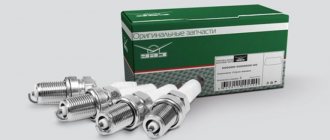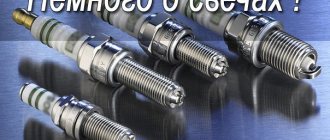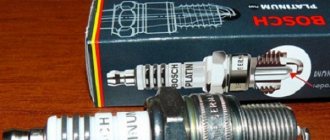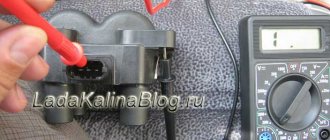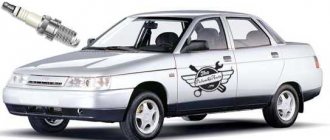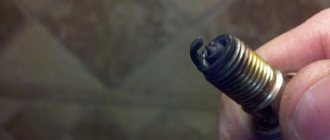The more electrodes, the better?
Many car enthusiasts are interested in spark plugs of non-standard, original designs, most often with 3 side electrodes. Having some advantages, they are not without drawbacks - that’s why they could not completely replace the conventional ones with 1 electrode.
Article on the topic: Replacing freon in a car air conditioner on your own
Contrary to popular misconception, not 3, but only 1 spark is formed on a 3-electrode spark plug: the current discharge “pierces” the gap with the least resistance, which depends on both the gap and carbon deposits on each individual electrode, temperature and chemical composition of the medium, different in each section of the combustion chamber. That is, only one electrode is always used, and the rest interfere with the normal effective spread of the flame and prevent a fresh portion of the combustible mixture from cooling the heat cone of the candle.
Product with 3 side electrodes
True, the service life of such products is longer, because, working alternately, its electrodes do not burn out longer. But this advantage was not decisive. Products in which one or both electrodes have a copper core have proven to be much more effective. At the moment a spark forms, they heat up better, and while waiting for the next one, they “cool down” faster.
Corporate catalog of analogues
Selecting Bosch spark plugs by car make is much more convenient than the “design” of markings described above based on the parameters of standard spark plugs. If only because not everyone has the opportunity (or even the desire) to measure a spark plug with a caliper and compare tables of heat numbers from different manufacturers.
The catalog of spark plugs posted on the Bosch website (unfortunately, not Russified) allows you to find an analogue of standard spark plugs even for rare cars that have already crossed the age threshold when they begin to be classified as oldtimers. It is not difficult to find modern mass-produced cars - the brands are listed in alphabetical order, it is difficult to get confused. Take, for example, the well-known Daewoo Matiz:
It is easy to notice that the same liter engine actually uses different spark plugs, and they are different in design - both the hexagons for the turnkey and the heat numbers are different.
The high quality of Bosch spark plugs has been noted all over the world. And thanks to the wide range, they are easy to choose for a car of any make and model. Bosch constantly strives to improve the quality of its products by conducting a wide range of scientific research and constantly introducing new technologies into the production process. Today it produces spark plugs from the most durable and high-quality materials. For example, the inclusion of the rare metal yttrium significantly extends the service life of products and provides higher performance characteristics.
Click to enlarge.
Bosch spark plugs.
Bosch produces spark plugs in two main series (differing in size) - Super and Super Plus. Reliable protection against radio interference is provided by additional resistances built into the product body at the production stage. They relieve electronic car control systems (such as ASR, ABS and ESP) from parasitic interference.
What does the operating period depend on?
Product with platinum contacts.
The service life of spark plugs depends on the following main factors:
- The qualitative composition of the fuel poured into the car. The use of low-quality fuel (the presence of a large number of additives, lead, in fuel) disrupts the operation of the power unit, leads to increased carbon formation, and affects the life of the spark plugs.
- Motor condition. If the power unit is faulty, various types of carbon deposits form on the spark plug, making it difficult for a spark to pass through and resulting in a reduction in the service life of the spark plugs and the car engine.
- Driving style. Long-term driving at high speeds, prolonged use of the vehicle under excessive loads leads to overheating of the spark plug contacts, carbon formation, and a decrease in spark plug life.
- Prolonged warm-up of the car engine and prolonged stay in traffic jams do not allow the temperature in the cylinders to exceed 450 0C. At this temperature, self-cleaning of the SZ occurs, therefore, without achieving it, the service life of the products is reduced.
- The cooling system is working properly. Malfunctions of the cooling system result in overheating of the motor, unstable heat removal from the spark plugs and their excessive overheating, as a result of which the material of the spark plug contacts loses its properties. Thus, SZ wear out faster.
- Design features of the SZ. The use of contacts made of various alloys that are resistant to high temperatures, corrosion, and so on. Increasing the number of spark plug electrodes helps to increase the service life of the spark plugs. If one contact fails and fails, a spark will occur at the second. Multi-electrode spark plugs can last up to 60 thousand km.
Manufacturers indicate the period of use of the SZ, corresponding to the use of these products on fully serviceable engines under ideal operating conditions. According to the standards for an electronic ignition system, spark plugs must last 20 thousand km, in the case of a classic system - 30 thousand km. The actual spark plug life is several times longer, but it is difficult to achieve due to non-ideal operating conditions.
We recommend watching a video about the need for timely replacement of protective equipment:
Removing and installing the ignition coil
Floating speeds and uneven engine operation can be caused not only by non-working spark plugs. Sometimes this happens due to a faulty ignition coil. In this case, it must be replaced with a new one.
To do this you will need a T25 TORX key:
- Disconnect the wire from the negative terminal of the battery.
- Disconnect the high-voltage wire ends from the ignition coil
- Disconnect the low voltage wiring harness from the ignition coil.
- Remove the four screws securing the ignition module
- Remove the ignition coil
- Install the parts in the reverse order of removal.
Before installation, lubricate the ends of the high-voltage wires with grease, such as petroleum jelly.
Selection by car
When selecting a Bosh spark plug for a car, the length of the threaded section must correspond to the standard spark plugs. A longer thread, protruding into the combustion chamber, will become overgrown with carbon deposits and, when turned out, will damage the threads in the head (on a number of engines, a spark plug that is too long may even collide with the valves or piston). A plug that is too short will cause interruptions in engine operation due to poor ventilation of the spark gap: an insufficient amount of fresh mixture will flow there, which is ignited at the moment of spark formation.
Variations in electrode extension are permissible only within a small range. In the most compact combustion chambers with a centrally located spark plug, the offset is small. In eight-valve engines of the classical design, where the spark plug is located on the side and its spark gap is less well purged with fresh air-fuel mixture, the offset increases in order to bring the spark gap deeper into the combustion chamber.
Multi-electrode spark plugs have an additional symbol in the marking: D for two-electrode (double), T for three-electrode (triple), Q for four-electrode (quadriple).
To designate the electrode material, the symbols C (copper), E (nickel-yttrium), P (platinum), S (silver), I (platinum-iridium) are provided.
The last symbol indicates the gap between the electrodes:
Increasing the gap relative to the standard one allows you to increase the power of the spark discharge, facilitating ignition of the mixture. But at the same time, the load on the ignition system also increases, and the risk of breakdown of high-voltage wires or the ignition coil increases.
The applicability of Bosch spark plugs is described quite accurately by the markings. For example, let’s look at the selection of an analogue for the common domestic A17DVRM. Let's start with the thread and type of seal - 14 * 1.25, crimp ring, spark plug wrench 21. Therefore, the first letter in the marking should be W. Since the spark plug has an interference suppression resistor, the second letter of the marking is R. Analyzing the characteristics of Bosch spark plugs In terms of heat ratings, we find that GOST “17” here will correspond to 7. Since the thread length of the A17DVRM is 19 mm (taking into account the thickness of the ring in the uncompressed state), and the stickout of the electrode is small, the next marking symbol is D.
